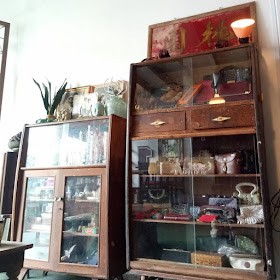With such an illustrious colonial history – Portuguese, Dutch, British – and a host of ethnic syntheses – Chinese, Malay, Arabic – Malacca, a city at the crossroads of east and west, is understandably rich in antiques. The centre of the old city, Jonker Street, is rightly famous for small vintage stores that very commonly are also cafes. Here you can find a myriad of old oddments and collectables, in some instances going back centuries. The city has been a bridge between cultures since well before the times Europeans ventured to south-east Asia in pursuit of spices and trade. It remains so today: it features as a trading hub in modern China’s plans for a new maritime ‘silk road’. Tourism, of course, brings its own degradations, as always - and so will Chinese money - but the spirit of the old city (one of the great historic cities of the world) still lives in the little shops in the laneways and ‘jalans’ away from the tourist traps. There are treasures to be found and bargains to be had.
One of the true delights waiting to be discovered is a café/collectables upcycle shop called ‘Vintage Daughter’. It is run by a Miss Ling and her family, with her father doing the cooking. It is the best of its type. It is a welcome journey into another time and another world. The pictures on this page are all of Miss Ling's cafe. It is a capsule of old Malacca - not the Malaccan heritage dressed up for the tourists, but genuine old homewares and bits and pieces of an authentic past.
The Chinese came to these parts beginning in the Xth century, but arrived in numbers in the XVth to XVIIth centuries. Those that settled became known as ‘Peranakan’ (perra – na – kan) and developed a distinctive language, cuisine and culture. They prospered, especially, by becoming intermediaries between the colonial rulers and the local Malays. In particular, they found common cause with the British and Peranakan culture was Anglocized up until the arrival of the Japanese during WW2 and Malaysian independence thereafter. The British, of course, imported the paraphernalia of British culture wholesale – books, furniture, artifacts, household items, all the trappings of the mother country. These are now floating around in the secondhand trade; beautiful items of the British colonial era, along with their imitations. The Chinese (Peranakan), too, devoted their prosperity to items of fine taste and domestic leisure. Malaysian independence (and Islamic ascendancy), along with the pervasive tastelessness of later modernity, has brought much of that rich past to a close, and so stores are replete with Chinese odds and ends as well. Miss Ling loves to surround herself with all of this nostalgia. You can immerse yourself in her café and listen to jazz and The Girl from Ipanema and enjoy cups of thick, dark black nanyang kopi.
The past has a warmth that nourishes in a way that the shiny new cannot. (This is a theme of 'Out of Phase', after all.) Nostalgia is not an empty sentimentality. It is a positive commitment to continuity, heritage and ancestry. It is funny, is it not?, how places such as these attract Bohemians who otherwise shun conservative creeds. It is the same in Australia from whence comes the present author - leftist radicals congregate around the 'heritage' regions, buy old homes and collect antiques. (Conversely, so-called 'conservatives' fund and cheer the bulldozers that wipe away the past to replace it with shopping malls of steel and glass and crass Americana. Such are the paradoxes of our political divides.)
We need hardly mention that family and ancestors are essential Chinese values. 'Vintage Daughter' is a family business in the richest and most immediate sense. The deep presence of a past when life was full of fine things - even when life was comparatively poor and hard - is everywhere. This is, of course, the meaning of 'upcycle'. What the shallow modernist would cast away as junk has been rescued and restored to a present virtue. This is very much the philosophy of the store. Miss Ling has ventured into the commercial worlds of Perth (Australia) - she studied media at Murdoch University - and the brash hurly burly of Kuala Lumpur, but she prefers (by philosophy and temperament) the quiet creativity of Malacca. It is her home, but she is inspired by its historical soul. This is reflected in the way she photographs all the items in her store. The photographs are, firstly, to record the items as they come in and to put them up for sale on-line, but they are also small works of art in themselves. Most of the photos on this present page are hers. (This post is as much about her photographs as about her cafe.)
And you can smoke! (Malacca is yet to succumb to the puritanism that has blighted the West, although UNESCO ties its 'World Heritage' funding to smoking bans in cities such as this. In Georgetown, up the Malacca Straits from here, UNESCO has made it a condition of funding that citizens of the town are to be forbidden from smoking not only on the streets and in the cafes, but in their own homes!!)

And then there is the food. Beautiful food, presented beautifully on beautiful crockery with beautiful utensils. It is a small family cafe with a limited menu located on Jalan Bunga Raya - around the corner from Little India, not on the main paths of the tourist trade - but the charming Miss Ling gives perfect attention to every element of her presentation.
* * *
Photographs of photographs. The store features an extensive collection of old photographs (and maps too!)
*
* *
* * *
Yours,
Harper McAlpine Black

























































